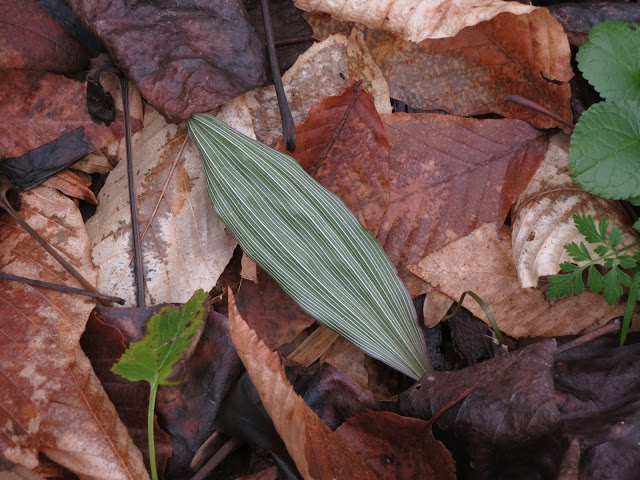Orchids vary greatly in color and form, but all have 3 petals and 3 sepals. One petal, often called the lip, is often quite specialized to facilitate cross-pollination. This is particularly obvious in the lady's slipper orchids, where one petal actually forms a pouch. In my previous posts I illustrated the Pink, Showy and Yellow Lady's Slippers, and Ohio has another slipper called the White Lady's Slipper (Cypripedium candidum). This diminutive plant grows in only two places in the state and has a fairly limited range overall. We were really pleased to find it in its best known location, Resthaven Wildlife Area near Lakeside. Check out this lovely flower:
In my first orchid post I said that these flowers ranged from spectacular to inconspicuous. Here are a couple that are very easily overlooked, but are no less exciting to us!
First is an unusual plant called Puttyroot (Aplectrum hyemale). You might remember that this winter I mentioned seeing the single leaf of this plant:
When the leaf emerges in autumn from the ground, it is fairly vertical, but after the tree leaves have fallen around it the Puttyroot leaf lays down horizontally, the better to absorb energy from the sun. The leaf persists all winter and then by the time the plant blooms in the spring the leaf has disappeared.
This spring we re-visited some spots where we had seen the leaves and we weren't disappointed. Here is what a blooming Puttyroot looks like; it is easily overlooked and can hide quite well in the surrounding vegetation!
Another inconspicuous orchid is the Lily-leaved Twayblade (Liparis liliifolia). This small woodland orchid is really hard to photograph! Here is one of our better attempts:
The large purplish lip is one of the three petals, and the threadlike extensions that you can see are the other two. Three sepals are also present. The reproductive parts are in the column above the large "lip" petal, and the white tube in the rear of the flower contains the nectar. Here is a photo from another angle:
Last weekend on the way home from Mothapalooza we stopped at one of the small Adams County prairies in southern Ohio. Most of the prairie flowers aren't in bloom yet, but we were really thrilled to find several Ragged Fringed Orchids (Plantanthera lacera), a plant that we had never seen before.
The delicate feathering of that lower "lip" petal was just amazing. The next picture shows a close-up of some of the flowers in profile view. The arrow points to the nectar tube of one of the flowers. Its length hints at the plant's pollinator--an insect would need a long, straw-like "tongue" to reach the nectar at the bottom. Indeed, these plants are pollinated by noctuid moths and hawkmoths that have a long proboscis ideal for reaching this plant's nectar.
So there you have it--four more beautiful and very different orchids. We have seen a few more this week, so stay tuned for more orchid posts!
First is an unusual plant called Puttyroot (Aplectrum hyemale). You might remember that this winter I mentioned seeing the single leaf of this plant:
When the leaf emerges in autumn from the ground, it is fairly vertical, but after the tree leaves have fallen around it the Puttyroot leaf lays down horizontally, the better to absorb energy from the sun. The leaf persists all winter and then by the time the plant blooms in the spring the leaf has disappeared.
This spring we re-visited some spots where we had seen the leaves and we weren't disappointed. Here is what a blooming Puttyroot looks like; it is easily overlooked and can hide quite well in the surrounding vegetation!
Another inconspicuous orchid is the Lily-leaved Twayblade (Liparis liliifolia). This small woodland orchid is really hard to photograph! Here is one of our better attempts:
The large purplish lip is one of the three petals, and the threadlike extensions that you can see are the other two. Three sepals are also present. The reproductive parts are in the column above the large "lip" petal, and the white tube in the rear of the flower contains the nectar. Here is a photo from another angle:
Last weekend on the way home from Mothapalooza we stopped at one of the small Adams County prairies in southern Ohio. Most of the prairie flowers aren't in bloom yet, but we were really thrilled to find several Ragged Fringed Orchids (Plantanthera lacera), a plant that we had never seen before.
The delicate feathering of that lower "lip" petal was just amazing. The next picture shows a close-up of some of the flowers in profile view. The arrow points to the nectar tube of one of the flowers. Its length hints at the plant's pollinator--an insect would need a long, straw-like "tongue" to reach the nectar at the bottom. Indeed, these plants are pollinated by noctuid moths and hawkmoths that have a long proboscis ideal for reaching this plant's nectar.
So there you have it--four more beautiful and very different orchids. We have seen a few more this week, so stay tuned for more orchid posts!








Beautiful photos Deb! Glad you had fun at Mothapalooza. I did, too. :)
ReplyDelete